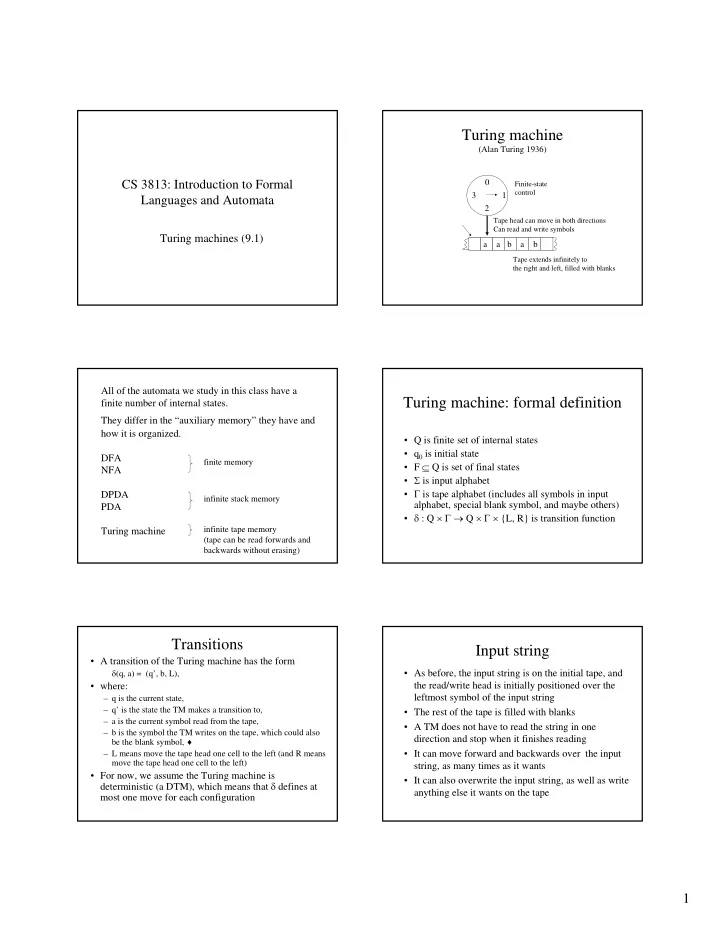

Turing machine (Alan Turing 1936) CS 3813: Introduction to Formal 0 Finite-state control 3 1 Languages and Automata 2 Tape head can move in both directions Can read and write symbols Turing machines (9.1) a a b a b Tape extends infinitely to the right and left, filled with blanks All of the automata we study in this class have a Turing machine: formal definition finite number of internal states. They differ in the “auxiliary memory” they have and how it is organized. • Q is finite set of internal states • q 0 is initial state DFA finite memory • F ⊆ Q is set of final states NFA • Σ is input alphabet • Γ is tape alphabet (includes all symbols in input DPDA infinite stack memory alphabet, special blank symbol, and maybe others) PDA • δ : Q × Γ → Q × Γ × {L, R} is transition function infinite tape memory Turing machine (tape can be read forwards and backwards without erasing) Transitions Input string • A transition of the Turing machine has the form δ (q, a) = (q’, b, L), • As before, the input string is on the initial tape, and the read/write head is initially positioned over the • where: leftmost symbol of the input string – q is the current state, – q’ is the state the TM makes a transition to, • The rest of the tape is filled with blanks – a is the current symbol read from the tape, • A TM does not have to read the string in one – b is the symbol the TM writes on the tape, which could also direction and stop when it finishes reading be the blank symbol, ♦ • It can move forward and backwards over the input – L means move the tape head one cell to the left (and R means move the tape head one cell to the left) string, as many times as it wants • For now, we assume the Turing machine is • It can also overwrite the input string, as well as write deterministic (a DTM), which means that δ defines at anything else it wants on the tape most one move for each configuration 1
Halting Acceptance • When does a TM halt? – when it reaches a configuration for which • We can define how a TM accepts a string in there is no transition defined different ways. – when it enters a final state (we will assume • We will say that it accepts a string if it halts in no transitions are defined for a final state) final state. It rejects the string if it halts in • It is important to note that a TM does not some other state, or does not halt at all. necessarily halt. It can enter an infinite loop. Exercises Example • Recall that the following languages are not The following diagram represents a TM that accepts context-free. the language denoted by the regular expression a*b*. – {a n b n c n |n ≥ 0} a → a,R b → b,R – {ww | w ∈ {a,b}*} ♦ → ♦ ,L b → b,R • In English, describe how a Turing machine q0 q1 q2 could accept each of these languages ♦ → ♦ ,L • Try to draw the transition diagrams for the How do you write the transitions for this? Turing machines Configuration Model of computation • A configuration of a TM includes everything • A TM is an abstract model of a computer we need to know to continue a computation that lets us define in a precise, mathematical – current state way what we mean by computation. – symbol currently under the tape head – string on tape to left of the head (up to leftmost • As before, we use the concept of a non - b lank symbol) “configuration” to define what we mean by – string on tape to right of the head (up to computation. rightmost non - b l ank symbol) • Example – (q, a, abb, bbb) 2
Computation Computing functions • A computation is a sequence of • We use automata to recognize languages and configurations such that each configuration compute functions (although we haven’t talked is obtained from the previous configuration about computing functions until now). by some transition of the TM • In fact, computing functions allows language recognition, since every language can be represented by a characteristic function – if the input string is in the language, output 1 – otherwise output 0 String and numeric functions Transducers • A TM can compute functions on strings. Given an input string, the output of the function is the string left • We can create TMs that compute arithmetic on the tape after the TM halts. functions such as addition, subtraction, • A TM can also compute numeric functions. Using a multiplication, etc. binary alphabet for strings, the input string can represent a binary number and the output string can • A TM that computes other things besides represent a binary number. (A unary alphabet can language acceptance is called a transducer. also be used, as in the book.) A transducer computers some output (which • A TM can compute a function with multiple could be anything) for some input. arguments. Each argument is separated by a special character, delimiter, on the tape. Exercise Construct (or describe how to construct) a TM that computes the numeric function f(k) = k + 1. 3
Recommend
More recommend